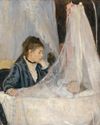
It’s 2019 in Washington, D.C., and Theo is changing his art-history dissertation after finding a painting of a horse in his neighbor’s giveaway pile. He is 26 years old, a Black Londoner (his mother is Yoruba, his father Californian) and a former star polo player. He left the sport for academia because of relentless racist harassment, and now studies stereotypes of Africans in British painting. The working title for his dissertation is Sambo, Othello, and Uncle Tom: Caricature, Exoticization, Subalternization, 1700–1900. He jogs with his dog for exercise, careful to wear his Georgetown shirt because “his favorite run took him through lily-white Northwest Washington and Daniel, his best friend at Yale, had instructed him that a Black man, running, should dress defensively.” Because he’s from the U.K., he may not understand all the nuances of American racism, but he understands enough. When the lady across the street, from whom he got the horse painting, flinches as he approaches to help her, he feels “the usual gust of anger” and takes a deep breath, saying to himself: “Just a White woman, White-womaning.”
Denne historien er fra July - August 2022-utgaven av The Atlantic.
Start din 7-dagers gratis prøveperiode på Magzter GOLD for å få tilgang til tusenvis av utvalgte premiumhistorier og 9000+ magasiner og aviser.
Allerede abonnent ? Logg på
Denne historien er fra July - August 2022-utgaven av The Atlantic.
Start din 7-dagers gratis prøveperiode på Magzter GOLD for å få tilgang til tusenvis av utvalgte premiumhistorier og 9000+ magasiner og aviser.
Allerede abonnent? Logg på

The Dark Origins of Impressionism
How the violence and deprivation of war inspired light-filled masterpieces

The Magic Mountain Saved My Life
When I was young and adrift, Thomas Manns novel gave me a sense of purpose. Today, its vision is startlingly relevant.

The Weirdest Hit in History
How Handel's Messiah became Western music's first classic

Culture Critics
Nick Cave Wants to Be Good \"I was just a nasty little guy.\"

ONE FOR THE ROAD
What I ate growing up with the Grateful Dead

Teaching Lucy
She was a superstar of American education. Then she was blamed for the country's literacy crisis. Can Lucy Calkins reclaim her good name?

A BOXER ON DEATH ROW
Iwao Hakamada spent an unprecedented five decades awaiting execution. Each day he woke up unsure whether it would be his last.

HOW THE IVY LEAGUE BROKE AMERICA
THE MERITOCRACY ISN'T WORKING. WE NEED SOMETHING NEW.

Against Type
How Jimmy O Yang became a main character

DISPATCHES
HOW TO BUILD A PALESTINIAN STATE There's still a way.